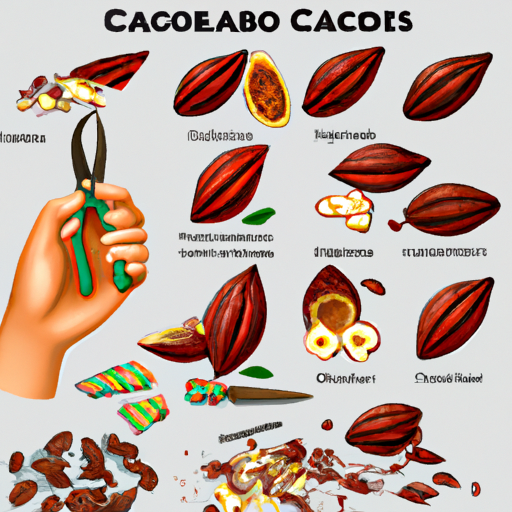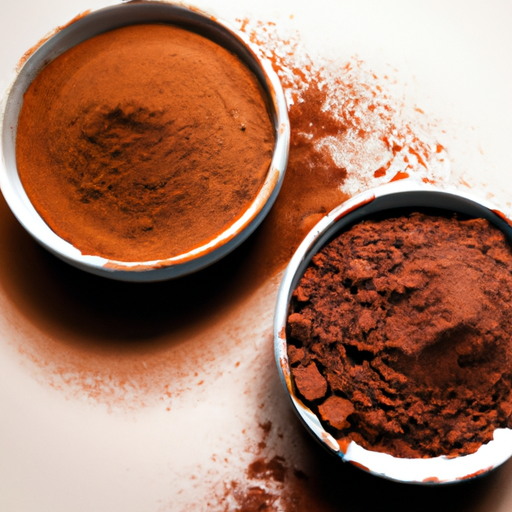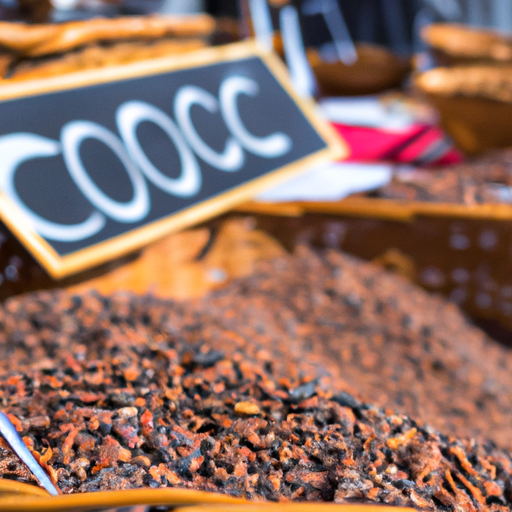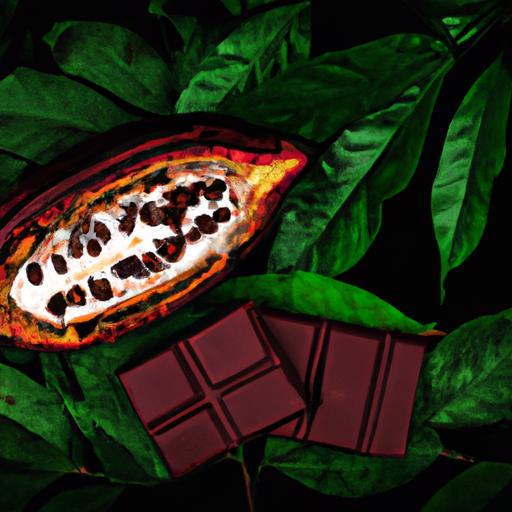I have always been fascinated by the process of how raw cacao nibs are created, as a chocolate lover. It feels like uncovering the mysteries of nature’s sweet factory.
Picture this: deep in the heart of tropical rainforests, cacao pods hang delicately from the trees, resembling precious jewels waiting to be discovered. With skilled hands, farmers harvest these pods, carefully extracting the precious seeds inside.
These seeds then undergo a fascinating transformation. Through the meticulous steps of fermentation, drying, roasting, grinding, and refining, the raw cacao nibs are slowly crafted into the delectable treat we all know and love. It’s a journey that requires patience, expertise, and a deep understanding of the art of chocolate making.
But the result is worth it. Not only do raw cacao nibs boast a rich, complex flavor, but they also offer numerous nutritional benefits.
In this article, we will delve into the intricate process of how these delightful nibs are made and explore creative ways to enjoy them.
Key Takeaways
- Cacao pod harvesting in tropical rainforests supports fair trade and local communities, while employing sustainable practices like agroforestry.
- Fermentation is a crucial step in raw cacao nibs production as it develops flavors, reduces bitterness, and improves health benefits.
- Drying and roasting techniques are employed to remove moisture, prevent mold/bacteria growth, deepen flavors, and remove moisture and bacteria.
- Grinding and winnowing of roasted cacao beans breaks them down into smaller particles, separates cacao nibs from shells, and ensures a smooth and impurity-free final product.
Harvesting Cacao Pods
To obtain the best raw cacao nibs, carefully harvest the cacao pods when they are fully ripe. Cacao pod harvesting is a crucial step in obtaining high-quality cacao nibs. Sustainability practices are essential at this stage, ensuring the long-term viability of cacao farming and minimizing environmental impact.
Many cacao farmers employ sustainable practices, such as agroforestry, which promotes biodiversity and conserves natural resources. Cacao pod harvesting also has a direct impact on local communities. Supporting fair trade practices and providing fair wages to farmers contributes to the economic development of these communities.
Proper cacao pod harvesting sets the foundation for producing exceptional raw cacao nibs. As we move on to the subsequent section about the fermentation process, it is important to note the significance of this initial step.
Fermentation Process
During fermentation, the cacao beans undergo a transformation that brings out their rich and complex flavors. This crucial step in the production of raw cacao nibs involves specific fermentation techniques.
After the cacao pods are harvested, they are opened to expose the beans and their surrounding pulp. The beans and pulp are then placed in shallow containers or wooden boxes and covered with banana leaves or other materials to create a controlled environment. This environment promotes the growth of microorganisms that ferment the beans over a period of several days.
This fermentation process is essential as it not only develops the unique flavors of the cacao beans but also reduces their bitterness and astringency. Additionally, fermentation contributes to the health benefits associated with raw cacao nibs, such as improved cardiovascular health and enhanced mood.
Once fermentation is complete, the beans are ready for the next step: drying and roasting, where their flavors will further develop.
Drying and Roasting
After the fermentation process, the transformed cacao beans go through the crucial step of drying and roasting to enhance their flavors even further.
Drying techniques play a vital role in removing excess moisture from the beans and preventing the growth of mold or bacteria. The traditional method involves spreading the beans out in the sun to dry naturally, but this can take up to a week. To expedite the process, modern techniques such as mechanical drying or using specialized drying rooms with controlled temperatures and humidity levels are employed.
Once dried, the beans are ready for roasting. Roasting methods vary depending on the desired flavor profile, but common techniques include hot air roasting, drum roasting, or even open-fire roasting. The roasting process not only deepens the flavors but also helps to remove any remaining moisture and bacteria.
With the drying and roasting complete, the next step is grinding and winnowing to transform the roasted beans into cacao nibs.
Grinding and Winnowing
The grinding and winnowing process turns the roasted beans into a fine powder that is as smooth as silk. Grinding techniques involve breaking down the roasted cacao beans into smaller particles. This can be achieved using various methods such as stone grinders or modern machinery like ball mills. The goal is to create a fine powder that enhances the flavor and texture of the final product. Once the beans are ground, the winnowing process is used to separate the cacao nibs from the shells. This is done by using airflow or mechanical agitation to blow away the lighter shell fragments, leaving behind the pure cacao nibs. The grinding and winnowing steps are crucial in preparing the cacao nibs for further processing. These steps help to ensure that the final chocolate product is smooth and free from any unwanted impurities. Moving on to the subsequent section about ‘conching and refining’, these steps further refine the cacao nibs and enhance the flavor and texture of the chocolate.
Conching and Refining
Conching is a critical process in chocolate production that aims to develop the smoothness and flavor of the final product. During conching, the chocolate paste is continuously agitated and heated, allowing the cocoa solids and cocoa butter to blend together, resulting in a velvety texture and enhanced flavor.
Refining the cacao nibs is another crucial step, as it involves reducing the particle size of the cocoa solids to achieve the desired texture in the chocolate. This process ensures a smooth and creamy mouthfeel, making the chocolate more enjoyable to consume.
The process of conching to develop smoothness and flavor
To achieve a velvety texture and enhance the flavor of the cacao nibs, you’ll need to undergo the process of conching. Conching involves gently grinding the nibs for an extended period of time. It is a crucial step in developing flavors and enhancing smoothness in cacao nibs.
During conching, the nibs are continuously agitated and heated. This allows the cocoa butter to melt and distribute evenly throughout the mixture. The agitation also helps remove any unwanted bitterness and acidity, resulting in a smoother and more balanced taste.
Conching also allows the flavors to fully develop. It does this by breaking down complex molecules and releasing volatile compounds that contribute to the overall aroma and taste. Once the conching process is complete, the cacao nibs are ready for the next step of refining to achieve the desired texture.
Refining the cacao nibs to achieve desired texture
Now that you’ve achieved a smooth and flavorful mixture through conching, it’s time to refine the cacao nibs to achieve the desired texture.
This step is crucial in improving the taste and flavor of the final product. Refining involves further grinding and processing of the conched chocolate mass.
The goal is to reduce the particle size of the cocoa solids and sugar to create a smooth and creamy texture. This is typically achieved by passing the mixture through specialized equipment called a refiner.
The refiner consists of two large granite wheels that rotate and grind the chocolate mass, gradually reducing the particle size. As the nibs are refined, the motion generates heat, which helps in further developing the flavor.
Once the desired texture is achieved, the chocolate is ready for the next step of tempering and molding, where it will be transformed into its final form.
Tempering and Molding
Tempering is a crucial step in chocolate making as it ensures the proper texture and appearance of the final product. By carefully controlling the temperature and cooling process, the cocoa butter in the chocolate is able to form stable crystals, resulting in a glossy finish and a smooth, snappy texture.
Once the chocolate is properly tempered, it is poured into molds to create nibs. These nibs can be in various shapes and sizes, ready to be enjoyed or used in further chocolate creations.
The importance of tempering for proper chocolate texture
Implementing the process of tempering is crucial in order to achieve the desired smooth and glossy texture of chocolate. The science of tempering involves carefully controlling the temperature of the chocolate to ensure that the cocoa butter crystals form in a stable and uniform structure.
This process not only gives the chocolate its characteristic shine, but also prevents it from developing a grainy or dull appearance. Troubleshooting tempering issues, such as graininess or blooming, requires a deep understanding of the chemistry involved.
By following specific temperature guidelines and techniques like seeding or tabling, the cocoa butter crystals can be manipulated to produce a velvety texture. Once the chocolate is perfectly tempered, it is ready to be poured into molds to create the delectable cacao nibs.
Pouring the tempered chocolate into molds to create nibs
To create your own delectable chocolate treats, it’s time to pour that perfectly tempered chocolate into molds and let your creativity shine.
Molding techniques play a crucial role in achieving the desired shape, texture, and appearance of the final product. When it comes to chocolate molds, there are various options available, including silicone molds, polycarbonate molds, and metal molds. Each type of mold offers different benefits and considerations.
For instance, silicone molds are flexible and easy to release the chocolate from, while polycarbonate molds provide a glossy finish. It is important to ensure the molds are clean and dry before pouring the tempered chocolate to prevent any imperfections.
Once poured, the chocolate needs to be allowed to cool and solidify in the molds before being removed. This step ensures that the chocolate maintains its desired shape and texture.
Moving on to packaging and storage, it is essential to protect the chocolate from moisture and temperature fluctuations to maintain its quality and taste.
Packaging and Storage
When you store your raw cacao nibs properly, like locking them up in an airtight container, you’ll keep their rich and intense flavor intact, making each bite a delightful explosion of chocolaty goodness.
To ensure the long-lasting freshness of your cacao nibs, it is essential to employ effective packaging techniques and follow storage tips.
Firstly, choose a container that is made of a material that provides a strong barrier against moisture and light, such as glass or a high-quality plastic. Additionally, consider using vacuum-sealed bags or containers to minimize exposure to air and prevent oxidation.
Store the container in a cool, dry place, away from direct sunlight and strong odors. This will help maintain the nibs’ quality and prevent them from absorbing any unwanted flavors.
Proper packaging and storage will preserve the nutritional benefits of cacao nibs, which we will explore in the next section.
Nutritional Benefits
Let’s now delve into the nutritional benefits of raw cacao nibs. As an athlete, I’m always on the lookout for foods that can enhance my performance and overall health. Raw cacao nibs are an excellent choice due to their abundance of nutrients.
They are packed with antioxidants, which can help reduce inflammation and protect against oxidative stress. Additionally, raw cacao nibs contain high levels of flavanols, which have been shown to support heart health by improving blood flow and reducing the risk of cardiovascular diseases.
These nibs are also a great source of magnesium, iron, and fiber, all of which contribute to a healthy diet.
With their numerous health benefits, raw cacao nibs are a valuable addition to any athlete’s nutrition plan. Now, let’s explore creative ways to enjoy these nutritious nibs without missing a beat.
Creative Ways to Enjoy
Indulge yourself in the rich and decadent world of raw cacao nibs. Sprinkle them over your morning yogurt or blend them into a velvety smoothie. These creative recipes not only add a burst of flavor but also provide numerous health benefits.
Raw cacao nibs are packed with antioxidants, fiber, and essential minerals like magnesium, iron, and zinc. Incorporating them into your diet can help improve cardiovascular health, reduce inflammation, and boost mood and cognitive function.
For a delectable treat, try adding raw cacao nibs to homemade granola bars or energy balls. The crunchy texture and intense chocolate flavor will elevate your snacks to a whole new level.
Additionally, use them as a topping for desserts like ice cream or incorporate them into baked goods for an extra layer of indulgence.
So go ahead and get creative with raw cacao nibs. Your taste buds and body will thank you!
Frequently Asked Questions
How long does it take for cacao pods to fully ripen before they can be harvested?
Cacao pods take approximately 5-6 months to fully ripen before they can be harvested. During this time, the pods undergo a complex maturation process, which involves changes in color, size, and flavor, ensuring optimal quality for the subsequent production of raw cacao nibs.
What is the purpose of fermentation in the cacao nibs production process?
The purpose of fermentation in the cacao nibs production process is to develop the complex flavors and aromas of the beans. After fermentation, the beans are dried, which further enhances their flavor profile.
How are cacao nibs dried after fermentation, and how does this affect their flavor?
To enhance the flavor of cacao nibs, they are dried after fermentation using various methods such as sun drying or hot air drying. This process allows for the development of complex flavors and aromas in the nibs.
Can you explain the grinding and winnowing process in more detail?
To grind cacao nibs, they are first roasted and then ground into a paste, called cocoa liquor. This paste is then pressed to separate the cocoa solids from the cocoa butter. The winnowing process involves removing the husks from the nibs.
What is the significance of conching and refining in the production of raw cacao nibs?
Conching and refining play a crucial role in the production of raw cacao nibs. The process involves grinding the nibs to a smooth consistency and reducing their particle size, resulting in improved flavor, texture, and aroma.
What is the process of making raw cacao nibs and how are they used in cooking and baking?
The process of making raw cacao nibs involves roasting and crushing the cacao beans to extract the nibs. These small pieces can be used in cooking and baking to add a rich, chocolate flavor to recipes. From adding them to smoothie bowls to incorporating them into healthy energy bites, the raw cacao nibs ideas are endless.
Conclusion
In conclusion, the process of making raw cacao nibs involves several intricate steps that ensure the highest quality and nutritional benefits.
First, the cacao pods are harvested from the cacao tree. These pods contain the cacao beans, which are the key ingredient for making the nibs.
Once the pods are harvested, they are opened and the beans are removed. The beans are then fermented for several days. This fermentation process helps to develop the flavor and aroma of the cacao beans.
After fermentation, the beans are dried. This can be done by laying them out in the sun or using a specialized drying machine. The drying process helps to remove any excess moisture from the beans.
Once the beans are dried, they are roasted. Roasting helps to enhance the flavor of the beans and also helps to remove the outer shell, known as the husk.
After roasting, the beans are ground into a paste. This paste is then pressed to separate the cocoa solids from the cocoa butter. The cocoa solids are what make up the cacao nibs.
The nibs are then further refined to create a smooth texture. This can be done by grinding the nibs or using specialized equipment to create a finer consistency.
One example of enjoying raw cacao nibs is by incorporating them into a homemade granola recipe. The crunchy texture and intense chocolate flavor of the nibs add a delightful twist to the traditional breakfast staple, leaving you satisfied and energized throughout the day.










